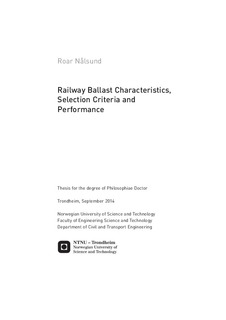| dc.contributor.author | Nålsund, Roar | nb_NO |
| dc.date.accessioned | 2014-12-19T11:35:36Z | |
| dc.date.available | 2014-12-19T11:35:36Z | |
| dc.date.created | 2014-12-08 | nb_NO |
| dc.date.issued | 2014 | nb_NO |
| dc.identifier | 769610 | nb_NO |
| dc.identifier.isbn | 978-82-326-0430-2 (printed ver.) | nb_NO |
| dc.identifier.isbn | 978-82-326-0431-9 (electronic ver.) | nb_NO |
| dc.identifier.uri | http://hdl.handle.net/11250/233318 | |
| dc.description.abstract | This work is a comprehensive investigation to find to what extent simple laboratory tests e.g. Los Angeles abrasion and micro-Deval might be suitable for predicting real railway ballast performance with respect to deformation and degradation. A number of tests to measure essential properties of ballast aggregate have been performed in addition to advanced material testing. Large cyclic triaxial loading test and full scale railway track model test were employed to simulate the effects of train loading and tamping, and to study settlement, stiffness and degradation of a range of ballast materials. The testing programme included both wet and dry testing conditions. All the rock types tested were mainly composed of combinations of principal rock-forming silicate minerals. They represent all together a wide variety of igneous, metamorphic and consolidated/metamorphosed sedimentary rocks mainly fine to very fine grained.
Mechanical properties
Change in the ballast grading proved to affect the ballast breakage development over time. However, the abrasion property expressed by the micro-Deval value did not show any association with the degradation of ballast under repeated load testing. Simulation of repeated tamping seemed to be the main source of ballast breakage.
Most rocks showed high frost resistance after long term impact, but samples with high content of amphibole were less frost resistant. The rocks’ mechanical strength in terms of the Los Angeles abrasion or micro-Deval value did not show any correlation with either the amount of microcracks or the rocks’ average mineral grain size. A new method to measure the amount of microcracks based on luminescence measurements was developed. It is suggested that micro-cracks represent open channels for water to penetrate into the aggregate, which was confirmed by good correlation between water absorption and the amount of micro-cracks.
Moisture had generally a negative effect on rocks’ mechanical strength according to Los Angeles abrasion and Point Load strength results. On the other hand, dry and wet triaxial tests with cyclic loadings did not confirm this effect. Neither did mineral grain size distribution show any correlation with mechanical strength, but the range of coefficient of conformity (Cu = D60/D10) was probably too narrow to obtain a reliable conclusion. A new method to quantify the mineral grain size distribution was developed under these test series.
Functional properties
Both resilient modulus of the ballast layer and the stiffness of the track were governed by the materials’ grading curve and specific density. A possible relation between the amount of microcracks in the aggregate and resilient modulus as well as ballast breakage is suggested. The permanent vertical strain during repeated load testing was affected by both the micro-Deval value, the grading curve of the ballast and the aggregate’s content of soft minerals.
Improvements of test methods
The Los Angeles abrasion test distinguished clearly between the superior quality material and the very poor material. The Los Angeles abrasion value is, however, a poor parameter to indicate how the intermediate material will behave in service regarding ballast breakage.
This study proposes to improve the ranking of ballast materials by introducing two additional methods. One which is able to measure some rocks’ ability to recover mechanical strength after repeated crushing, and one which measures the production of fines (0/0.125 mm) during crushing.
Saturation of ballast material before micro-Deval testing did not have any significant effect on degradation. Neither did the use of 1 % sodium-chloride solution have any effect. | nb_NO |
| dc.language | eng | nb_NO |
| dc.publisher | Norges teknisk-naturvitenskapelige universitet, Fakultet for ingeniørvitenskap og teknologi, Institutt for bygg, anlegg og transport | nb_NO |
| dc.relation.ispartofseries | Doktoravhandlinger ved NTNU, 1503-8181; 2014:259 | nb_NO |
| dc.title | Railway Ballast Characteristics, Selection Criteria and Performance | nb_NO |
| dc.type | Doctoral thesis | nb_NO |
| dc.contributor.department | Norges teknisk-naturvitenskapelige universitet, Fakultet for ingeniørvitenskap og teknologi, Institutt for bygg, anlegg og transport | nb_NO |
| dc.description.degree | PhD i bygg, anlegg og transport | nb_NO |
| dc.description.degree | PhD in Civil and Transport Engineering | en_GB |

